Porcelain from the East and earthenware from the neighbourhood – Remarks on the pottery from Dutch Fort Katuwana
https://doi.org/10.34780/5b21-f4fw
Abstract
In 2006, investigations at Katuwana Fort provided an assemblage of foreign porcelain and local earthenware. The porcelain might have reached the fort around 1735, matching at best to ceramics from the shipwreck cargo of Ca Mau. It was disposed in a period between 1761 and 1766 together with the local earthenware. At that time major repairs were reportedly undertaken after 1761. Nevertheless, the fort was abandoned in 1766 and the Dutch Period ended. 1797, the fort was re-used for a short period by British forces, but fi nally given up already in 1805. This provides a limited range of time for the dating of the pottery assemblage with a glimpse into the variety of ceramics available in a fort related to the Indian Ocean trade of that time. Besides fine Chinese export porcelain also favoured in Europe, they used durable crockery made in Southern Chinese kilns and in Japan. This coarse and thick-walled porcelain was mainly distributed in Asia but also bought by the VOC as offi ce equipment. In opposite thereto, it is suggested that local earthenware consists of more recent forms and being representatives for the period around 1761 to 1766. Most of them are of domestic day-to-day function with easy availability in the neighbourhood and therefore more up-to-date. A few sherds among the porcelain fi nds are of uncertain context but according to comparisons, they could have reached the Fort only during the short British period.
The article will be available as a PDF in the near future.
Schlagwörter:
Sri Lanka, Excavation, Chinese ceramics, Hizen, VOC, Indian Ocean




